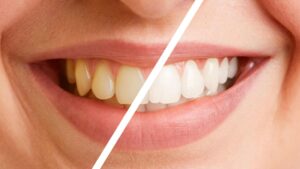Teeth Whitening: The Gateway to a Brighter Smile
Brief Overview of the Teeth Whitening Process
Teeth whitening is a cosmetic procedure aimed at lightening the shade of the teeth, thus enhancing one’s smile. Over time, our teeth can become stained or discolored due to factors like food, drink (coffee, tea, wine), smoking, and age. The whitening process uses agents like hydrogen peroxide or carbamide peroxide to break stains into smaller pieces, which makes the color less concentrated and the teeth brighter.
Professional In-Office Whitening vs. At-Home Kits
Professional In-Office Whitening: Performed by dentists, this process offers faster results and often utilizes stronger whitening agents. A protective barrier is applied to gums, and a specially formulated gel is placed on the teeth. Sometimes, a specialized light or laser is used to accelerate the whitening process. The results can be seen immediately, often in under an hour.
At-Home Kits: These are available over-the-counter or through your dentist. They offer the flexibility of whitening your teeth at your convenience, but results may take longer – often several weeks. They consist of trays, strips, or paint-on products and have a lower concentration of active ingredients compared to in-office treatments.
Benefits and Considerations for Teeth Whitening
Benefits:
Enhanced appearance: A brighter smile can boost self-confidence and make you feel more attractive.
Affordable: Compared to other cosmetic procedures, teeth whitening can be more accessible and cost-effective.
Improved oral health: While primarily cosmetic, the process can motivate individuals to maintain better oral hygiene.
Considerations:
Sensitivity: Some individuals might experience increased tooth sensitivity or gum irritation after the procedure.
Not Permanent: Teeth whitening isn’t permanent, and the duration of results varies based on individual habits and the method used.
Not for Everyone: Not all types of discoloration can be treated with whitening, such as grayish-hued teeth or discoloration due to medication.
Maintenance and Care Post-Whitening
Once you’ve achieved that desired shade, it’s crucial to maintain the results:
- Avoid foods and drinks that stain for the first 48 hours post-procedure. After that, consume them in moderation.
- Use a straw for beverages that might stain to minimize contact with teeth.
- Brush twice a day, floss daily, and consider using a whitening toothpaste to help remove surface stains.
- Refrain from smoking or using tobacco products.
- Regular dental check-ups can help in maintaining your brighter smile. Some individuals also opt for touch-up sessions once a year or as recommended by their dentist.
Teeth whitening is a sought-after procedure, offering an accessible way for individuals to enhance their smile. By understanding the process, its benefits, and care considerations, one can make an informed decision and enjoy a radiant smile for years to come.
Dental Veneers: Crafting the Ideal Tooth Appearance
What are Dental Veneers?
Dental veneers are thin shells, often made from porcelain or composite resin, that are custom-designed to cover the front surface of teeth. They serve to improve the appearance of teeth by changing their color, shape, size, or length. Veneers can correct a variety of dental imperfections, such as discolored, chipped, misaligned, or gapped teeth, offering an immediate transformation to a more aesthetically pleasing smile.
Porcelain vs. Composite Veneers: Pros and Cons
Porcelain Veneers
Pros:
- Durability: Can last between 10-15 years with proper care.
- Stain Resistance: Porcelain is resistant to stains, keeping the veneers looking pristine for longer.
- Natural Appearance: They have a translucent quality that mimics natural teeth.
Cons:
- Cost: Typically more expensive than composite veneers.
- Irreversible: A small amount of enamel must be removed from the tooth, making the procedure irreversible.
- Repair: If they break or chip, a new veneer typically needs to be made.
Composite Veneers
Pros:
- Cost: Generally less expensive than porcelain veneers.
- Reversible: Little to no enamel needs to be removed, making the procedure potentially reversible.
- Repair: Easier to fix if damaged.
- Speed: Often can be done in one dental visit.
Cons:
- Durability: Typically last 4-8 years, less than porcelain veneers.
- Stain Prone: More susceptible to staining compared to porcelain.
- Appearance: Might lack the same translucency and natural appearance of porcelain
The Procedure: From Consultation to Final Placement
Consultation: Discuss with the dentist the desired outcome, where the suitability for veneers is assessed, and a treatment plan is made.
Preparation: A small amount of enamel (typically 0.5mm) is removed from the tooth’s surface to make room for the veneer. An impression or mold of the tooth is taken and sent to a dental lab where the veneer is custom-made.
Temporary Veneer: Depending on the dentist’s recommendation, a temporary veneer might be placed while waiting for the permanent veneer.
Bonding: Before permanently cementing the veneer, the dentist will place it on your tooth to ensure a proper fit and color. Adjustments can be made at this stage. The tooth is then cleaned, polished, and etched (roughened) to allow for a strong bonding process. Special cement is applied to the veneer, which is then placed on the tooth. A special light beam is used to activate chemicals in the cement, causing it to harden quickly.
Evaluation: A follow-up visit might be recommended to check the veneer’s placement and the health of the gums around it.
Suitability and Longevity of Dental Veneers
Dental veneers are suitable for individuals who want to correct cosmetic imperfections like discoloration, chips, minor misalignment, or gaps. However, they might not be suitable for individuals with weak or unhealthy teeth, insufficient enamel, or those who grind their teeth.
In terms of longevity, with proper care, porcelain veneers can last between 10-15 years, while composite veneers typically last between 4-8 years. Factors affecting their lifespan include oral hygiene practices, dietary habits, and potential trauma to the teeth.
Dental veneers offer a compelling solution for those looking to significantly enhance their smile in a short timeframe. By understanding what veneers are, their types, the procedure, and their longevity, individuals can make a well-informed choice about this cosmetic dental treatment.
Dental Implants: The Gold Standard for Missing Teeth
Understanding Dental Implants and Their Importance
Dental implants are titanium posts that are surgically positioned into the jawbone beneath the gum line, serving as an artificial tooth root. Once in place, these implants allow your dentist to mount replacement teeth onto them. Because implants fuse to the jawbone, they provide stable support for artificial teeth, ensuring dentures and bridges mounted to implants won’t slip or shift in the mouth. This secure fit is especially beneficial when eating and speaking, making the wearer feel as though the implant is a natural part of their mouth.
The significance of dental implants becomes apparent when understanding the consequences of missing teeth. A missing tooth can lead to bone loss over time, causing remaining teeth to shift, impacting the bite and facial aesthetics. Implants help in maintaining the structural integrity of the jawbone and ensuring a balanced bite.
Steps Involved in the Dental Implant Procedure
Consultation and Planning: An initial evaluation where X-rays are taken, and a comprehensive dental examination is done to ensure the patient is a good candidate for implants.
Tooth Extraction: If the damaged tooth is still present, it will be removed.
Jawbone Grafting (if necessary): If there’s not enough bone or it’s too soft, bone grafting might be required to ensure a solid foundation for the implant.
Implant Placement: A titanium post is surgically inserted into the jawbone. This will function as the root of the artificial tooth.
Osseointegration (Healing): The jawbone will grow and unite with the surface of the dental implant, a process that can take several months.
Abutment Placement: Once healing is complete, a small connector post (abutment) is attached to the post to hold the new tooth.
Artificial Tooth Placement: Finally, an artificial tooth (crown) is then securely attached to the abutment.
Advantages of Choosing Implants Over Dentures or Bridges
Natural Feel and Appearance: Implants feel, fit, and function like natural teeth, offering a more natural biting and chewing capability.
Durability: Implants are designed to last a lifetime with proper care, making them a cost-effective solution in the long run.
Bone Health: They prevent bone loss, a common issue following tooth loss.
Oral Health Benefits: Unlike tooth-supported bridges, implants don’t require reducing other teeth, thus preserving the natural tooth structure.
Stability: Implants are securely anchored and don’t slip or shift, offering a reliable solution, especially when eating and speaking.
Caring for Dental Implants for Maximum Lifespan
Taking care of dental implants is similar to caring for natural teeth:
Regular Brushing and Flossing: This ensures the removal of food particles and prevents plaque buildup.
Regular Dental Checkups: Visits to the dentist at least twice a year are essential to monitor the implants and ensure optimal oral health.
Avoid Chewing Hard Items: Biting down on hard items like ice or hard candy can damage both natural teeth and the crown on the implant.
Avoid Smoking: Smoking can weaken the bone structure and can contribute to implant failure.
Dental implants have revolutionized restorative dentistry, offering a robust and long-lasting solution for missing teeth. With an understanding of their benefits, the procedure, and proper care practices, one can enjoy the confidence and functionality that comes with a complete smile.
Dental Bonding: A Quick Fix for Minor Flaws
Exploring the Concept of Dental Bonding
Dental bonding is a cosmetic dentistry procedure in which a tooth-colored composite resin material is applied to a tooth and hardened with a special light. This bonding process allows the material to adhere to the tooth, improving or restoring a person’s smile. Dental bonding is often used for cosmetic purposes to improve the appearance of discolored or chipped teeth. It’s also employed to close gaps between teeth, make teeth look longer, or change their shape and color.
The Step-by-Step Dental Bonding Procedure
Color Selection: The first step involves selecting a composite resin color that closely matches the shade of the patient’s tooth. This ensures the bonding blends in naturally.
Tooth Preparation: The surface of the tooth will be slightly roughened, and a conditioning liquid will be applied. This aids in ensuring the bonding material adheres securely.
Bonding Application: The tooth-colored, putty-like resin is then applied, molded, and smoothed to the desired shape.
Hardening: An ultraviolet light or laser is employed to harden the resin. Once set, the dentist will further trim, shape, and polish the material to match the sheen of the rest of the tooth.
Finishing Touches: Adjustments can be made to perfect the appearance and bite.
The entire process typically takes 30 minutes to an hour per tooth and is often completed in a single visit.
Ideal Candidates for Dental Bonding
Dental bonding is a suitable choice for individuals looking to make minor cosmetic dental changes or for those who have smaller cosmetic issues that need addressing. This can include:
Teeth with minor chips or cracks.
Discolored teeth.
Teeth with gaps or minor spacing issues.
Teeth that appear too short or are slightly misshapen.
To protect a portion of a tooth’s root that may have been exposed due to gum recession.
It’s worth noting that while bonding can address many issues, it may not be the best choice for major dental problems or for those looking for a long-lasting solution.
Maintenance and the Expected Duration of Dental Bonding
Dental bonding, with proper care, can last anywhere from 3 to 10 years, depending on the location of the bonding and individual oral habits.
To maximize the lifespan of dental bonding:
- Oral Hygiene: Regular brushing and flossing are essential to prevent decay around the bonded tooth.
- Avoid Staining: For the first 48 hours after bonding, avoid consuming foods and drinks that can stain, such as coffee, tea, and red wine. The resin is more susceptible to stains during this period.
- Avoid Hard Foods and Chewing Objects: Don’t chew on hard objects like ice, pens, or fingernails, as this can chip the bonding material.
- Regular Dental Checkups: Routine dental visits will ensure the bonded teeth are in good condition and can be polished to retain their luster.
Dental bonding offers an efficient and cost-effective way to address minor dental imperfections. By understanding what dental bonding is, the procedure, and its maintenance, individuals can make an informed decision about this cosmetic dental option.
Making the Right Choice for Your Smile
Assessing Your Dental Needs and Desires
Before embarking on any cosmetic dental procedure, it’s crucial to introspectively assess what you hope to achieve. Do you want a brighter smile? Are there minor imperfections you wish to correct, or are you looking to replace missing teeth? By understanding your needs and desires, you’ll be better equipped to discuss potential treatments with your dentist.
The Importance of a Thorough Consultation with a Cosmetic Dentist
A comprehensive consultation with a qualified cosmetic dentist is indispensable. Here’s why:
Expert Evaluation: A dentist can provide a professional assessment of your oral health, identifying underlying issues that might need addressing before cosmetic procedures.
Options Exploration: Dentists can outline various treatments suitable for your specific needs and desires, helping you understand the pros and cons of each.
Visualization: Modern cosmetic dentistry often employs tools like digital imaging to show potential results, giving you a glimpse of what to expect.
Address Concerns: This is your opportunity to voice any anxieties, ask questions, and discuss potential risks associated with treatments.
Budgetary Considerations and Insurance Coverage
Cosmetic dental procedures can be an investment. Here’s how to navigate the financial aspect:
Get a Cost Estimate: During your consultation, request a detailed breakdown of all associated costs for your desired procedures. This will help you plan and budget accordingly.
Insurance Inquiries: While many cosmetic procedures might not be covered by dental insurance, some treatments with health benefits might receive partial coverage. It’s essential to check with your insurance provider about potential reimbursements.
Financing Options: Some dental practices offer financing plans or collaborate with third-party financial institutions to provide payment options. This can make treatments more accessible by breaking down costs into manageable monthly payments.
Tailoring a Cosmetic Plan Unique to Your Smile
Every smile is unique, and so should be your cosmetic dental plan. By working closely with your cosmetic dentist, you can develop a customized approach that takes into consideration:
Priority: If multiple treatments are desired, decide which procedures should be addressed first based on urgency or desired impact.
Phased Approach: Instead of multiple treatments at once, you might opt for a phased approach over several months or years, giving time for recovery and budget management.
Holistic Consideration: Consider how each treatment integrates with the others, ensuring they complement one another to achieve the desired outcome.
Feedback and Iteration: After an initial procedure, assess your satisfaction. If adjustments are required, or if you desire further enhancements, these can be integrated into the ongoing treatment plan.
Making informed decisions about cosmetic dentistry involves a mix of personal reflection, professional guidance, and practical considerations. By focusing on these key areas, you’ll be better equipped to embark on a journey that will lead to a brighter, more confident smile tailored just for you.
Ready to Transform Your Smile?
Don’t wait any longer to achieve the dazzling smile you’ve always dreamt of. At Cleveland Dental Care, our team of experts is ready to guide you every step of the way. Book your appointment today and let’s embark on your journey to optimal oral health and confidence.
🔹 Book Your Appointment Now at Cleveland Dental Care 🔹
Frequently Asked Questions (FAQs)
1. What are the top four cosmetic procedures you recommend?
The top four cosmetic dental procedures we often recommend are Teeth Whitening, Dental Veneers, Dental Implants, and Dental Bonding. The best procedure for you depends on your individual needs and desired outcomes.
2. How long does teeth whitening last?
Teeth whitening can last from a few months to up to three years. This varies depending on the individual’s diet, oral hygiene habits, and the method of whitening used.
3. Are dental veneers permanent?
Dental veneers are considered a permanent procedure because a small layer of enamel is removed from the tooth surface before placing the veneer. However, veneers themselves can last anywhere from 10 to 20 years, depending on the type of veneer and how well they’re cared for.
4. How do dental implants compare to dentures?
Dental implants are surgically placed in the jaw and act as a replacement for the root of a missing tooth. They provide a permanent solution and prevent jaw bone loss. Dentures, on the other hand, are removable appliances that replace missing teeth. They can be full (replacing all teeth) or partial (replacing some teeth).
5. Is dental bonding a good solution for chipped teeth?
Yes, dental bonding is an excellent solution for minor cosmetic issues, including chipped, slightly cracked, or discolored teeth. It’s a less invasive and often more cost-effective option compared to veneers or crowns.
6. Do cosmetic dental procedures hurt?
While most cosmetic dental procedures cause minimal discomfort, some patients may experience slight sensitivity or pain. We ensure our patients are as comfortable as possible, using local anesthesia when necessary and providing post-procedure care instructions.
7. How much do these cosmetic procedures cost?
The cost of cosmetic dental procedures varies widely based on the specific treatment, materials used, the complexity of the procedure, and individual patient needs. We recommend scheduling a consultation for a detailed cost breakdown.
8. Will my insurance cover cosmetic dental procedures?
Dental insurance plans typically don’t cover cosmetic procedures as they are elective. However, some treatments that also have health benefits, such as dental implants, might receive partial coverage. It’s essential to consult with your insurance provider for specifics.
9. How long do these procedures take?
The duration of each procedure varies. For example, teeth whitening can be done in a single session, while dental implants require multiple visits spread over several months. We’ll provide a clear timeline during your consultation.
10. How do I know which procedure is right for me?
A thorough consultation with our expert cosmetic dentist is the best way to determine the most suitable procedure for your needs. Together, you’ll discuss your dental goals, assess your oral health, and map out a plan tailored to you.















